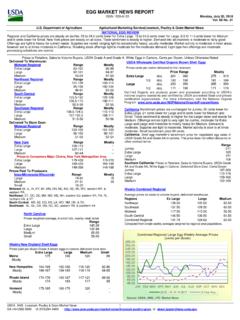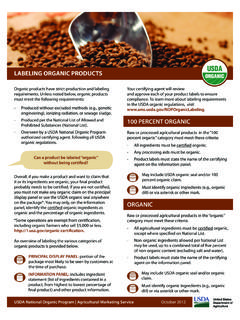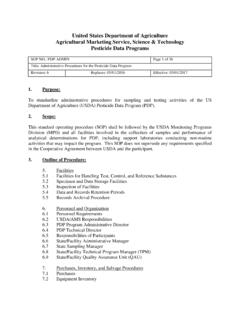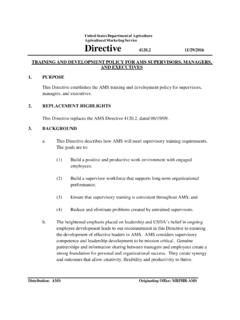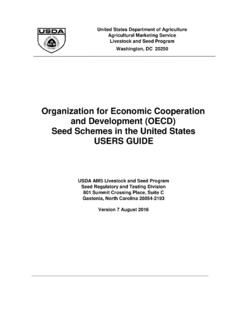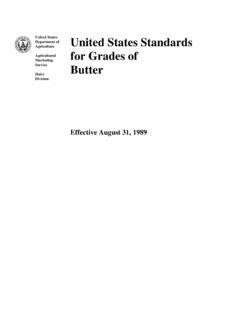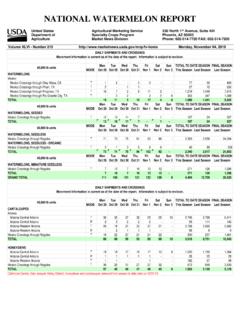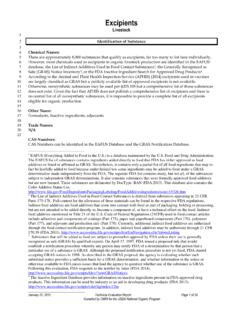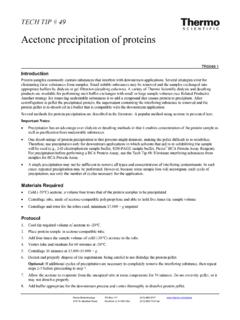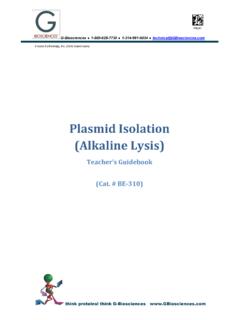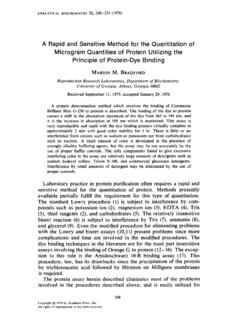Transcription of Whey Protein Concentrate - Agricultural Marketing Service
1 Whey Protein Concentrate (WPC) Handling 1 Identification of Petitioned Substance 2 Chemical Names: 3 Whey Protein Concentrate (WPC), WPC 34, WPC 55, WPC 80 4 5 Other Name: 6 Whey, proteins, Designer Whey, Milk basic Protein , Whey powders (permeate), Sweet whey Acid whey, 7 Demineralized whey products, Bioactive proteins/Whey fractions, Reduced lactose whey 8 9 Trade Names: 10 Whey Protein Concentrate , WPC, WPC 34, WPC80 11 CAS Number: 91082-88-1 (Guidechem, 2015) 12 13 EINECS (EC#):293-803-2 14 15 Summary of Petitioned Use 16 17 Currently, whey Protein Concentrate (WPC) is listed on USDA s N ational Organic Program s (NOP) 18 National List of allowed ingredients for use in or on processed products labeled organic.
2 19 This falls under the following section: 20 Nonorganically produced Agricultural products allowed as ingredients in or on 21 processed products labeled as organic. 22 23 Only the following nonorganically produced Agricultural products may be used as ingredients in or 24 on processed products labeled as organic, only in accordance with any restrictions specified in 25 this section, and only when the product is not commercially available in organic form. 26 27 (z) Whey Protein Concentrate . 28 29 The Organic Foods Production Act (OFPA), 7 6501 et seq., authorizes the establishment of the 30 National List of allowed and prohibited substances.
3 Exemptions and prohibitions granted under the OFPA 31 are required to be reviewed every 5 years by the National Organic Standards Board (NOSB). The NOSB 32 requested a technical evaluation report for WPC. WPC is scheduled to sunset on June 27, 2017. 33 34 Characterization of Petitioned Substance 35 36 Composition of the Substance: 37 38 There is approximately Protein in liquid bovine milk. This Protein fraction is composed of 20% whey 39 and 80% casein. Whey is the liquid substance obtained by separating the coagulum from milk or cream in 40 cheese making. In its raw liquid form, whey is composed of naturally occurring , water 41 (93%) Protein ( ), fat ( ), lactose ( ) and minerals-referred to as ash ( %).
4 Whey is the 42 collection of globular proteins isolated from the liquid fraction (micronutrients) that are biologically active- 43 beta ( ) - lactoglobulin, alpha ( )-lactalbumin, glycomacropeptide, bovine serum albumin, 44 immunoglobulins, lactoferrin and lactoperoxidase. The liquid whey becomes the starting material for whey 45 Protein Concentrate (WPC). Ultrafiltration, evaporation and drying are used to produce commercial 46 _____ April 24, 2015 Technical Evaluation Report Page 1 of 18 Compiled by USDA, AMS, Agricultural Analytics Division for the USDA National Organic Program Technical Evaluation Report Whey Protein Concentrate Handling/Processing ingredients with 34 to 80% Protein content in the dry product.
5 Additional steps are needed to make whey 47 Protein isolates (WPI) that have greater than 90% Protein content. 48 49 Table 1. Proximate Composition of Whey 50 Component % concentration Total solids Water Fat Phospholipid Whey Protein -Lactoglobulin -Lactalbumin Immunoglobulins Bovine serum albumin Proteose-peptone Lactoferrin Lactoperoxidase Glycomacropeptide Lactose Minerals Calcium Phosphorous Potassium Source: Smith, 2012. 51 52 Source or Origin of the Substance: 53 A process flow diagram for the production 54 of cheese and WPC is shown in Figure1.
6 55 56 Figure 1. 57 58 59 60 61 62 63 64 65 66 67 68 69 70 71 72 73 74 75 76 77 78 79 80 81 82 83 84 85 Source: Smith, 2012 86 Ultrafiltration Evaporator/Spray dryer Diafiltration Curds Cheese Whey Bleaching (optional) to remove color by using Hydrogen peroxide or Benzoyl peroxide. Organic or Raw Milk Fat separation Pasteurizer Pasteurized skim milk Rennet/Acid Standardized cheese milk Cream 1. Cream 2. Condensed Milk 3. Non-fat dry milk 50 to 80% Protein content WPC 30-50% Protein content WPC Ultrafiltration Evaporator/Spray dryer April 24, 2015 Page 2 of 18 Technical Evaluation Report Whey Protein Concentrate Handling/Processing Whey, by definition from 21 Code of Federal Regulations (CFR) , is the liquid substances 87 obtained by separating the coagulum from the milk or cream in cheese making.
7 The milk is often standardized 88 before cheese making in order to optimize the Protein (casein) to fat ratio. This is accomplished by adding 89 Protein solids ( , condensed skim milk and non-fat dry milk NFDM) to the standardized cheese milk 90 (SCM) in order to improve cheese (compositional) quality and production yields. Rennet (animal derived) 91 or chymosin preparation (fermentation-derived) 21 CFR calcium chloride (21 ), 92 and dairy cultures are added to the SCM. These nonorganic substances are allowed as ingredients in or on 93 processed products labeled as organic (7 CFR ).
8 The casein coagulates in the presence of rennet or 94 (lactic) acid to form the cheese curd. The pH of the cheese milk drops from to which causes the 95 casein Protein to coagulate and form a curd. The curd traps most of the lactose, fat, and ash. The liquid 96 whey Protein that remains is further processed into a variety of commercial ingredients from dried whey 97 (13 percent Protein ) to whey Protein concentrates (25 to 89 percent Protein ) and whey Protein isolates 98 (greater than 90 percent Protein ). One pound of cheese produces nine pounds of liquid whey Protein . In 99 high moisture fresh cheeses such as cottage cheese (where a portion of the original raw milk is returned to 100 the cheese as cream dressing) the ratio may be as low as 6:1 (Burrington, 2012b.)
9 , Etzel, 2004., Brown, 101 2014., and Walstra et al., 1999). 102 103 Properties of the Substance: 104 105 Whey is the soluble fraction of milk, rich in proteins, minerals and lactose that are separated from casein 106 during the manufacture of cheese or casein (Table 1 ). This separation is usually accomplished by 107 acidification to pH or through the action of rennet, a casein-coagulating enzyme preparation. In acid 108 coagulation, the pH is lowered either by microbial fermentation of the milk sugar lactose into lactic acid or 109 by direct addition of organic (lactic) acids.
10 The fermentation route is most often used in the production of 110 cottage cheese and other fresh cheeses, and is referred to as acid whey. In contrast, sweet wheys are 111 obtained in manufacture of cheddar, mozzarella and other hard cheeses using rennet coagulation to form 112 the curd. Since enzymatic clotting of milk by rennet occurs at pH or higher, the lactic acid content of 113 freshly obtained sweet whey is low and is controlled by pasteurization and refrigeration. In addition, rennet 114 whey contains glycomacropeptide, which is cleaved from kappa (k)-casein by chymosin to initiate 115 precipitation of the caseins forming curd (Foegeding et al.)
